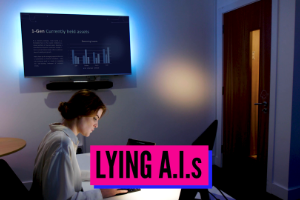
Professional Skills Training: Data Science

Lying A.I.s
The year is 2026. 1-GEN is one of the top three general insurers in the UK and top 10 in the EU. Like all other GI companies, 1-GEN uses AI (Artificial Intelligence) systems to dynamically price and underwrite policy applications and employ optimisation techniques to maximise profit within the allocated risk budget across policy lines.
Simon, an experienced Actuary and Data Scientist, has been doing some tail risk analysis on the contents lines and has done a ‘deep dive’ into the data that drives the systems. He finds inconsistencies but it doesn’t look like it’s a glitch in the system, rather an issue in how the AI has been programmed to maximise profits. He raises his concerns with Veronique who is the statutory reporting actuary. Veronique wonders whether, given that it could be a company-wide or industry-wide issue, should she report it immediately or give herself more thinking time and raise it once she better understands the scale of the problem.

Inside the Black Box
Black Box Insurance sets up Project Polar with a multidisciplinary team of actuaries and data scientists to implement a pilot using AI technology for insurance renewal pricing – quicker, faster, less human interaction for competitive advantage. Watch how this unfolds and issues that arise when the Board decides to skip the pilot and go straight to full implementation of the technology.

Out of Pandora’s Box
This is a follow-up video to 'Inside the Black Box'. Three months have passed since the initial roll-out of the AI (Artificial Intelligence) Pricing. The Black Box Board is delighted with the implementation and apparent benefits; Jo has also completed the relevant documentation and all seems well – but not for long! The data scientists highlight potential issues with the data whilst the Board has indicated a desire to extend the AI techniques to other areas of the business. There is also a forthcoming visit from the regulator to prepare for.
Out of Pandora’s Box
Brave New World
Two young entrepreneurs, Mac and Keevi, have set up a start-up app-based insurance company, Treasure, which is due to launch in a few months (when their regulatory licences come through). They want to offer a wide range of insurance products: home, motor, health, life, pet, travel, using the latest technology to price policies and market product offerings to consumers. While waiting to discuss their plans with the regulator, they get an unexpected challenge from a voice from the past!
Mini Case Studies

Could AI Go Awry?
Katherine is presenting a report to her colleague Leon. The visuals are very impressive and portray positive forecast projections for the upcoming year. Leon congratulates Katherine on her impressive report and supporting document pack but questions how she got to the figures in the chart. Katherine explains she pasted the customer data set into ‘CONVO-SIM’, a public AI-based tool, and assures Leon that everything will be fine, as the tool is ‘free from human error’. How can she be so sure? Leon wonders if he should say something.

Chat IT Over
Sébastien, an actuary working for a consultancy that designs chatbot algorithms, finds himself having to explain some inappropriate chatbot product recommendations to the Insurance Regulator.

Communicating Complexity
Li, an actuary, has the unenviable task of explaining her approach to develop a predictive model for pricing new health insurance products to the company's Strategy Committee.

Everyone’s an Expert
Marcus, the first in his team to undertake a course on machine learning techniques, has concerns when he hears that Elizabeth, the Senior Actuary, is proposing that she carries out an internal peer review of his work.
Everyone’s an Expert
Risky Business?
Ning, an actuary, works within a team of actuaries and data scientists which has developed an underwriting tool which uses machine learning from a variety of data sources. The results are used to calculate customer premiums based on a risk score. What are the implications?